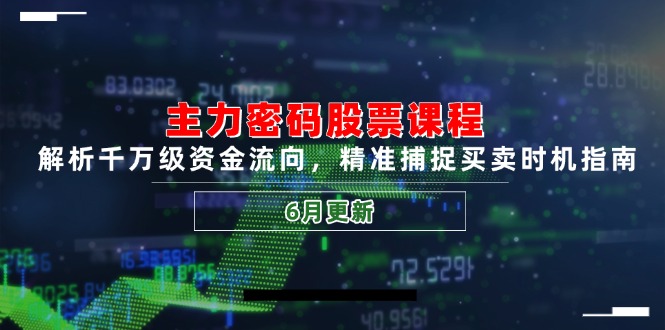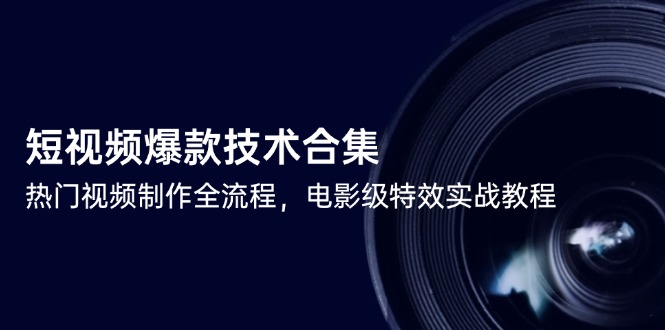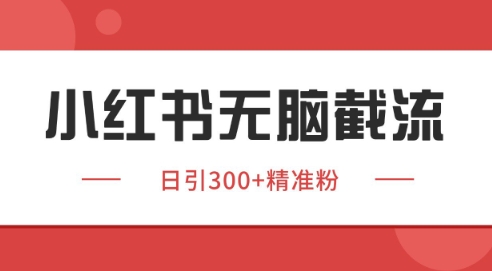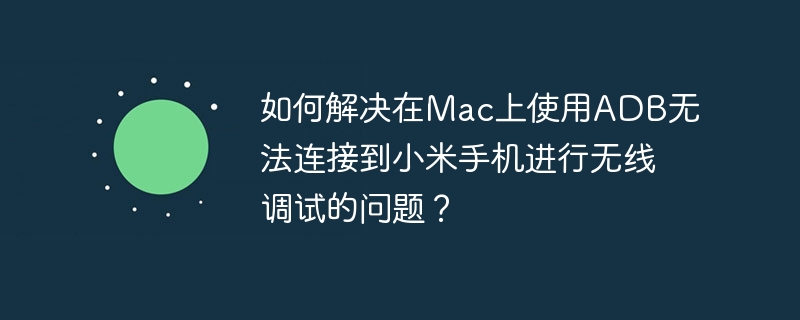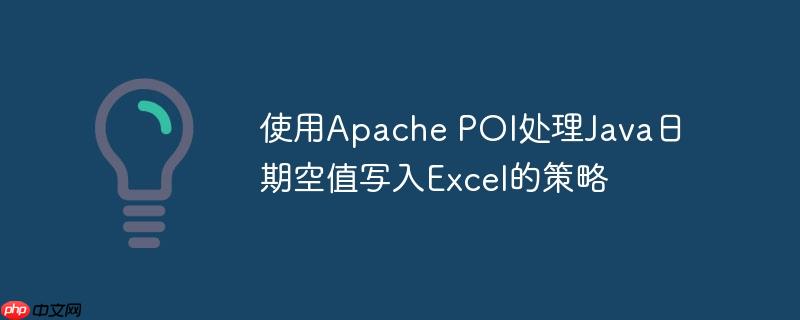
本文旨在解决使用apache POI库将Java中的java.util.date对象写入excel时,当Date对象为NULL时抛出NullPointerException的问题。核心策略是,在调用setCellValue()方法之前对日期对象进行空值检查,若为null则不设置单元格值,从而在Excel中保留为空白单元格,有效避免运行时错误并确保数据正确导出。
Apache POI日期空值处理的挑战
在使用apache poi将java对象的数据导出到excel文件时,开发者经常会遇到一个特定问题:当尝试将一个可能为null的java.util.date类型的字段写入excel单元格时,程序会抛出nullpointerexception。这是因为apache poi的xssfcell.setcellvalue(date value)方法在内部会尝试将传入的date对象转换为excel的日期数字格式,而这个转换过程依赖于一个非空的date实例。如果传入null,则会导致内部调用链(如dateutil.getexceldate或Calendar.settime)出现空指针异常。
考虑以下常见的代码片段,它试图将一个学生对象的入学日期(admissionDate)写入Excel:
import org.apache.poi.ss.usermodel.*; import org.apache.poi.xssf.usermodel.XSSFWorkbook; import java.io.FileOutputStream; import java.util.Date; import java.util.List; import java.util.ArrayList; // 假设Student类定义如下 class Student { private int id; private String name; private Date admissionDate; public Student(int id, String name, Date admissionDate) { this.id = id; this.name = name; this.admissionDate = admissionDate; } public int getId() { return id; } public String getName() { return name; } public Date getAdmissionDate() { return admissionDate; } } public class ExcelExporter { public static void generateExcelFile(List<Student> listOfStudent) { Workbook workbook = new XSSFWorkbook(); Sheet studentSheet = workbook.createSheet("Students"); // 创建表头 Row headerRow = studentSheet.createRow(0); headerRow.createCell(0).setCellValue("Id"); headerRow.createCell(1).setCellValue("Name"); headerRow.createCell(2).setCellValue("Admission_Date"); int rowNum = 1; for (Student student : listOfStudent) { Row studentRow = studentSheet.createRow(rowNum++); studentRow.createCell(0).setCellValue(student.getId()); studentRow.createCell(1).setCellValue(student.getName()); // 问题所在:如果student.getAdmissionDate()为null,这里会抛出NPE studentRow.createCell(2).setCellValue(student.getAdmissionDate()); } try (FileOutputStream outputStream = new FileOutputStream("students.xlsx")) { workbook.write(outputStream); System.out.println("Excel file generated successfully."); } catch (Exception e) { e.printStackTrace(); } finally { try { workbook.close(); } catch (Exception e) { e.printStackTrace(); } } } public static void main(String[] args) { List<Student> students = new ArrayList<>(); students.add(new Student(1, "Alice", new Date())); // 有日期 students.add(new Student(2, "Bob", null)); // 无日期,将导致NPE students.add(new Student(3, "Charlie", new Date())); generateExcelFile(students); } }
当student.getAdmissionDate()返回null时,上述代码将产生如下异常:
Exception in thread "main" java.lang.NullPointerException at java.util.Calendar.setTime(Calendar.java:1770) at org.apache.poi.ss.usermodel.DateUtil.getExcelDate(DateUtil.java:86) at org.apache.poi.xssf.usermodel.XSSFCell.setCellValue(XSSFCell.java:600) // ... 后续调用栈指向你的代码
这明确指出,XSSFCell.setCellValue方法在处理null日期时遇到了问题。
解决方案:空值检查与条件赋值
解决此问题的核心思想非常直接:在尝试将日期值设置到单元格之前,先检查该日期对象是否为null。如果为null,则不调用setCellValue()方法。Excel单元格在没有显式设置值时,默认就是空白的,这正是我们期望的“空值”表现。
立即学习“Java免费学习笔记(深入)”;
以下是修改后的代码片段:
import org.apache.poi.ss.usermodel.*; import org.apache.poi.xssf.usermodel.XSSFWorkbook; import java.io.FileOutputStream; import java.util.Date; import java.util.List; import java.util.ArrayList; // Student类定义同上 public class ExcelExporter { public static void generateExcelFile(List<Student> listOfStudent) { Workbook workbook = new XSSFWorkbook(); Sheet studentSheet = workbook.createSheet("Students"); // 创建表头 Row headerRow = studentSheet.createRow(0); headerRow.createCell(0).setCellValue("Id"); headerRow.createCell(1).setCellValue("Name"); headerRow.createCell(2).setCellValue("Admission_Date"); int rowNum = 1; for (Student student : listOfStudent) { Row studentRow = studentSheet.createRow(rowNum++); studentRow.createCell(0).setCellValue(student.getId()); studentRow.createCell(1).setCellValue(student.getName()); // 关键的空值检查 if (student.getAdmissionDate() != null) { studentRow.createCell(2).setCellValue(student.getAdmissionDate()); } // 如果student.getAdmissionDate()为null,则不执行任何操作,单元格保持为空白 } try (FileOutputStream outputStream = new FileOutputStream("students.xlsx")) { workbook.write(outputStream); System.out.println("Excel file generated successfully."); } catch (Exception e) { e.printStackTrace(); } finally { try { workbook.close(); } catch (Exception e) { e.printStackTrace(); } } } public static void main(String[] args) { List<Student> students = new ArrayList<>(); students.add(new Student(1, "Alice", new Date())); students.add(new Student(2, "Bob", null)); students.add(new Student(3, "Charlie", new Date())); generateExcelFile(students); } }
通过添加if (student.getAdmissionDate() != null)这一行简单的判断,我们成功避免了NullPointerException。当admissionDate为null时,相应的单元格将不会被设置任何值,在Excel中表现为预期的空白单元格。
最佳实践与注意事项
-
通用性:这种空值检查的策略不仅适用于Date类型,也适用于其他可能导致NullPointerException的对象类型。例如,如果你有一个自定义的对象类型需要序列化到单元格,也应该进行类似的空值检查。
-
不同数据类型的setCellValue行为:
-
显式设置空白单元格:虽然简单地不设置值通常就能达到目的,但如果你需要显式地将一个单元格设置为“空白”类型(CellType.BLANK),你可以这样做:
Cell cell = studentRow.createCell(2); if (student.getAdmissionDate() != null) { cell.setCellValue(student.getAdmissionDate()); } else { cell.setCellType(CellType.BLANK); // 显式设置为空白类型 }然而,在大多数情况下,CellType.BLANK与未设置值的单元格在视觉和行为上没有显著区别,因此简单的空值检查并跳过setCellValue更为简洁。
-
数据格式:对于日期单元格,即使是空值,如果你希望未来填充值时能自动识别为日期,可以预先设置单元格的日期格式。这不会影响空值本身,但会为非空日期提供正确的显示。
CellStyle dateStyle = workbook.createCellStyle(); CreationHelper createHelper = workbook.getCreationHelper(); dateStyle.setDataFormat(createHelper.createDataFormat().getFormat("yyyy-MM-dd")); // ... 在循环中 Cell dateCell = studentRow.createCell(2); if (student.getAdmissionDate() != null) { dateCell.setCellValue(student.getAdmissionDate()); dateCell.setCellStyle(dateStyle); } else { // 即使为空,也可以设置样式,但这通常不是必需的 // dateCell.setCellStyle(dateStyle); }
总结
在使用Apache POI将Java日期对象写入Excel时,处理null值是一个常见但容易被忽视的问题。通过在调用setCellValue()方法之前进行简单的空值检查,可以有效避免NullPointerException,并确保Excel中正确地表示空日期字段为无值的空白单元格。这种防御性编程实践不仅提高了程序的健壮性,也使得生成的Excel文件符合预期的数据表示。








